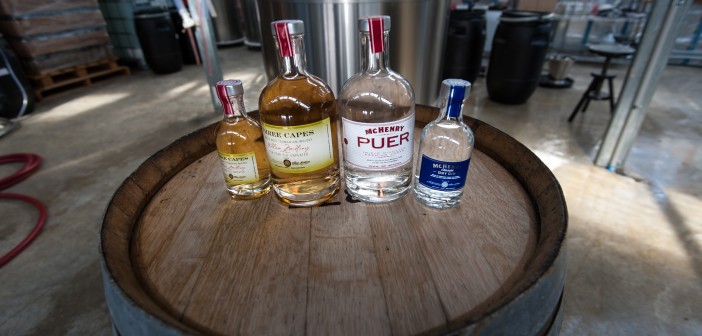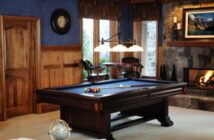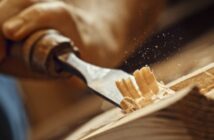There is a lot about the Port Arthur region that is iconically Australian. Obviously our convict past is represented significantly through the historic penal settlement, but it is so much more than that.
Nestled in the south-east corner of Tasmania, it is a wild environment with extreme conditions: the steep hills, jagged rocks, crashing waves and howling winds look like they were custom-created to separate the strong from the weak.
It is an area built on manual labour and hard toil – from the original timber yards, through to the prison and the subsequent farming – made all the more difficult by its remoteness to the rest of the State, let alone the country.
Yet this is part of what makes the area so magnetic. Despite the trying conditions, the difficult landscape and the isolation, it is still undeniably beautiful and ruggedly inspirational.
There is obviously something quite stirring about the area for William McHenry – enough to make him relocate his entire life and family from a corporate career in Sydney, to become an artisan whisky maker and spirits distiller at one of the southern-most points in Australia.
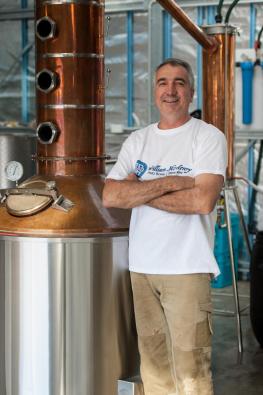
It is worth taking a second to put this in to context. A distillery can really be operated anywhere in the world. While advertising may suggest that all whisky is made in the rolling fields of the Highlands, surrounded by stone and block buildings and attended to by elderly gentlemen on rocking chairs … many distilleries are actually modern manufacturing facilities in industrial parks surrounded by factories. Quite simply, a clean water supply can be achieved by more than just flowing rivers nowadays.
However William was determined to create a true artisan distillery and that meant finding a pure and natural water supply. As such, the William McHenry & Son’s Distillery offers as much from its location as it does in its taste. It is set on 10-acres of steep land, just round the corner from the historic prison site, and under the shadow of Mount Arthur.
The magnificent copper still is housed in a simple rustic construction amidst classic oak barrels at the base of the property, surrounded by forest-like trees and steep pitched land, while the acres above are classic Tasman Peninsula pastures – beautiful on the right day, brutal the next. It holds an extraordinary view of the surrounding land, with some 40 acres of private forest and 60 acres of private pastures, creating a beautiful landscape reminiscent of a postcard.
However, what is also situated at the top of the property is the prime reason William purchased it: a number of free-flowing pure natural springs.
It’s a lovely respect to the art of whisky distilling and one that William takes great pride in.
“Historically the great distilleries of the world needed to utilise a local river or have a steady supply of clean natural rainfall,” says William. “While that’s obviously not such an issue in the modern age, I still believe you get a better product from pure, naturally occurring water – so the springs were a major factor in choosing the property.”
Despite the obvious attractions of the land, it is still an extraordinary shift in life from corporate professional to artisan distiller.
“I was working at a bio-tech company which went into receivership,” he explains. “Like a lot of companies in that situation, things dragged out for quite some time and that makes it stressful for everyone. Basically you turn up to work every day not knowing if it might be your last – and that went on for months.
“One day I was in my car and passed through an intersection, and then the next thing I know people were tooting and yelling at me. It turns out that I had driven through a red light but had no idea – I was so focused on the business and the various court cases and whether I would have a job after it… and it hit me pretty hard that there had to be something else in life to do.
“A few days later I was chatting to my neighbour about the incident with the car and what else might be out there in the world. As part of a bigger conversation, it came up how I actually had a family history in distilling and then he pointed out that I certainly had the name for it,” he laughs.
Let’s be honest, the neighbour has a point – when your name is William Fraser McHenry you should probably be making whisky … or bagpipes … and possibly wearing a kilt.
“That was really the conversation that got things going in my head. I had a background in winemaking many years before – so the concept wasn’t completely foreign – but I’d never actually considered making spirits for a living until then.
“I started researching heavily and so by the time I saw this property I knew exactly what I wanted and had little hesitation in putting in an offer.”

While the idea has a romantic charm, it was one that impacted the entire family. Naturally, William is very quick to credit the incredible support of his family to even entertain the idea, let alone commit to the move.
“It’s one thing to have the idea and the passion to want to do this, but I am also very blessed to have a selfless wife who believed in me and was willing to share in the dream,” he says.
Equally, there were a number of major logistics to work through: most notably the prospect of relocating a young family and the massive amount of work in setting up a business that would not have reasonable financial returns for a considerable period of time
“As beautiful as the property and the area is, it was never going to be practical to move the family to Port Arthur as a town; particularly with three children at school age,” he says.
As such, the family live in Hobart and William travels down to Port Arthur a few days a week to distil and bottle the product. And this is where we start to see the true determination of the man to make his dream work.
You see, William bought the property back in 2008 yet it took until almost 2011until he got round to building a small rudimentary hut in which to stay – up until that point he would simply camp out or sleep on a fold out bed in the distilling shed. Even now, he often prefers to stay in the shed as he is yet to put in running water for the hut.
It is worth remembering that this is one of the southern-most parts of Australia where it regularly snows in winter. That is determination indeed…
While he’s been in no hurry to concern himself with creature comforts, the rustic look of the distilling plant belies a well-planned operation.
For example, the water used in manufacturing comes in from the spring naturally cold, however it becomes very hot in the distilling process – rather than pump the hot water outside and potentially damage plants and wildlife, William runs it through a manifold and into the concrete slab of the distilling shed. Not only does this provide heating through the floor, but it also means that the water runs out as cold as it came in, protecting the environment.
Equally, considerable work has been put into the tapped spring. There is a simple, but effective, wooden fence around it to ensure animals can’t wander by and contaminate the soil while a cylindrical metal ring inserted deep into the ground (complete with cover), keeps it clean from debris. William has had the water tested and it is considered to be ‘very soft’ with no mineral taste at all; however even with all these precautions he still has four filters to ensure the water is perfectly clean for the distilling process.
Although there are other springs on the property to tap if required, he says he has never seen it slow or stop; irrespective of the season, temperature or condition.
With the operation settled and product flowing, there are bigger plans underway to put in a visitor centre complete with dining and commercial kitchen facilities so that William can hold food events and run official tastings.

But these things take time – not that you need to tell that to a whisky maker…
“The nature of making whisky is that the decisions and the work you are putting in today will be realised in 10 years’ time – so you have to be patient.”
It also requires an astute business brain to ensure you have some money coming in – after all, not many people in the world can cover 10 years of living expenses without a pay check.
“My passion is with the whisky, but I also make a Triple Distilled Vodka and a London Dry Gin of which I’m both very proud. The advantage of these spirits is that you can start selling them straight away and get some dollars back into the business. I’ve also been working on a Sloe Gin and a Dark Rum, which is good fun.
“I also offer sales of whisky by the barrel for people to buy as a long term investment and have been maturing some products in smaller barrels for a shorter turnaround… these sorts of decisions keep some money coming in.”
It’s a challenge to combine long term planning with immediate necessities, but William appears to take it with a steady head and welcoming smile. It is a fascinating mix of absolute determination with the patience of a saint, but it is quite apparent that there are ultimate ambitions to keep everything on track.
“I grew up in winemaking areas, so I know the importance of putting in work now so that you can fully realise it later on. Obviously any whisky maker wants to gain credibility for their product and that takes time. The great part for me is that the spirits industry as a whole is gaining traction and it’s wonderful to be part of that.
“Just as it took time for the world to realise that countries other than France can make quality wine, it’s been a challenge for distilleries around the world to break the perception that whisky can only come from Scotland and Ireland – but I believe there has been a lot of great work already done in Australia, and hopefully I can continue that well into the future.”
But just like those wine producers, it can take generations to truly build that credibility. While the thought of those ‘best years’ being well down the track may put some people off, it was a consideration that William saw as a positive.
“In the back of my mind is the thought of leaving a legacy for my family. The fantastic history of wine producers in Australia is based off the continuation of a family line with the business growing over generations. Without putting pressure on any of my children, I think it would be lovely to have that there if they are interested. It’s certainly not something I could have done with my work in bio-tech,” he laughs.
Despite all the hard work and considerable risk, it is – most of all – the realisation of a dream and one that William clearly has no regrets over.
As a one-man operation he has taken on everything required: hard work, extraordinary patience, long term planning, immediate necessities, ultimate ambitions, hands-on skilful work and a business brain.
It’s a bit too much for me to get my head around in one day – I think I need a drink…
The artisan distiller
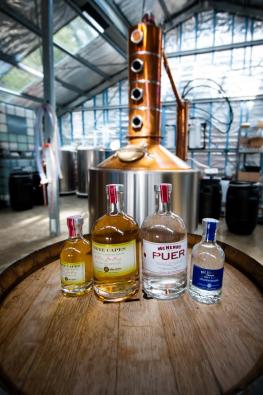
For many of us, the process of making a distilled spirit is shroud in mystery. While the look of a large copper still is clearly impressive, most of us don’t have a great idea of what is happening.
When I went to visit William, he was half way through a run of whisky. The still was fired up and emitting a toasty heat on a cool Tassie day – gauges and needles were flicking around – and a steady stream of clear liquid was running out the back. I had a flashback to high school chemistry and physics … albeit the most wonderful chemistry class you’d be ever be witness to.
While the machinery looks very sophisticated and impressive, a true artisan spirit is still very much a handmade product – and one that takes considerable skill.
Whisky starts its life from a base known as a ‘wash’. This wash is made to an individual’s recipe, but the skill is actually in the distilling.
“I like to refer to whisky as ‘grown-up’s beer’, as it effectively starts from the same base,” says William. “I get my wash made by Cascade Brewery as they are obviously a quality manufacturer and have the suppliers and equipment to make it at a better economy than I could.
“I get them to make that wash to my particular specifications so there are flavours and a depth of aromas that come through in the final product.”
William brings down roughly 6,000 litres of wash every month, which is put through a stripping run to remove water for a more concentrated liquid.
“We want to increase the flavour and the alcohol, and the stripping run takes the alcohol percentage from roughly 5% to a range of 25% to 30%.”
This is done through the distillation process in the magnificent copper pot-still. By controlling the temperature of the still, the alcohol will evaporate and turn into vapour before the water component. The alcohol vapour contains many of the desired flavours and so is captured, condensed and collected through the neck of the still before running out as a clear liquid.
“From there, I do a second distillation with the specific aim of looking for what we call ‘the heart’,” says William.
And this is where a lot of the skill of the whisky maker comes through. During this second run, the condensed vapour will flow through in stages. The first part will be largely dangerous elements like methanol, ethanol and some unwanted flavour components, and this is discarded. At a given point – determined by the whisky maker – ‘the heart’ will come through and that is captured and then matured in oak casks to become whisky. As the name would suggest, the heart only runs through the middle of the distilling process, so at a given point in time, William must decide when it has finished and divert the remaining liquid to also be discarded.
“The key is determining when the heart begins and getting the right conditions to get the most from it. From there, I transfer to oak casks and … well … wait 10 years for the results!”

It is interesting to note that the colour of whisky is purely from the time spent in the oak barrels – without that, it would be a clear spirit like gin or vodka. The specific colour is determined by what the barrel has been used for previously.
“Whisky uses second-hand oak barrels as new oak imparts too much flavour on the final product,” explains William. “Manufacturers of bourbon, port and sherry want new oak in their maturation – so the whisky guys will buy off them and the two groups effectively help each other.”
Those second-hand oak barrels will have been stained by whatever was in them previously, and that colour is then imparted on the whisky. The bourbon barrels will make the whisky a light, honey colour, while the port and sherry barrels impart a deeper, red-brown colour.
While the colour of the whisky is no representation of its flavour, human nature suggests that a darker colour will be stronger, so – perhaps quite sadly – many large distilleries will add a flavourless caramel colouring to keep customers happy.
Equally, one of the final processes in whisky making is the removal of ‘flocculants’ (the oils that come through the distillation) which are left to settle and then decanted off. Many of the volume whisky companies will filter that out, but can – in the process – strip a lot of the colour and flavour at the same time. Again, they will balance the colour back through with caramel colouring but the flavour can never be returned.
And for those who are wondering, William prefers the light honey texture and colouring from bourbon barrels – he decants rather than filters – and has no need to add colouring.
It’s the little touches that count.

